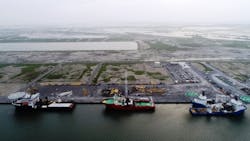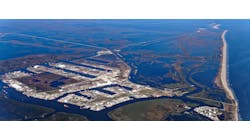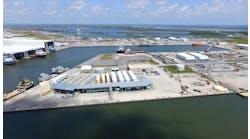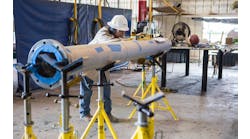Increased port facility enables greater range of service offerings
New technologies, specialized vessels deliver enhanced efficiencies
Judy Murray, Contributing Editor
As water depth capabilities have increased in the Gulf of Mexico (GoM), the companies that service offshore assets also have evolved. More capable rigs are working at greater depths than ever before, and new technologies are enabling safe and efficient operations in areas that a few years ago would have been considered unreachable.
When Oceaneering International began over 50 years ago – out of a merger between World Wide Divers and two other diving companies – rigs were working at water depths that could easily be managed by the divers, who carried out maintenance and repair activities. Over the years, Oceaneering has transformed from a small regional diving company into a global provider of ROVs and deepwater engineered products and services, umbilicals, subsea hardware, and tooling.
Leveraging location
Oceaneering has been working out of Port Fourchon to service GoM operators for 25 years. From its 22-acre facility, the company provides services to the entire region from shallow water to ultra-deepwater.
Tommy Lord, Subsea Projects Group operations manager, says working from the Port allows the company to reach its GoM customers easily, simplifying logistics and enabling the rapid delivery of services.
“From day one, we knew this was going to be the best location for us,” he said.
That realization led the company to increase its footprint in 2018, when Oceaneering moved its facility to the port’s Northern Expansion Slip B, which offers more storage space, parking, and a more expansive staging area. It also added more wharfage, which today totals 1,200 linear feet (366 m) of bulkhead.
According to Lord, the Greater Lafourche Port Commission (GLPC) has made it easy to expand and has invested in improving access to the Oceaneering facility, completing a paved roadway to accommodate increased traffic much more quickly than Lord and the other tenants in the area expected. “The Port is always moving forward to advance the collective interest of the tenants,” he said.
GLPC efforts are influenced by input from the tenants, he explained. “We have regular meetings, and they are always asking, ‘How can the Port help?’ That attentiveness to tenant needs makes Port Fourchon a good place to set up shop.”
In addition, security is exceptional. “The Port Police come by daily. They know all the tenants. They are always close by and always responsive,” said Lord.
The combined services and advocacy from the GLPC support the tenants, allowing the companies working in Port Fourchon to focus on themselves and their customers. “We couldn’t do it without them,” Lord said.
Advanced services
Oceaneering has executed a broad range of projects in the GoM supported by its Port Fourchon facility.
The company was engaged by a GoM operator to design and manufacture two 23,000-ft (7,000-m) dynamic power umbilicals that meet the environmental and mechanical demands of operating at ultra-deepwater to 9,000 ft (2,743 m). Dozens of designs with varying component configurations, armoring options, conductor materials, component sizing, and helix angles were developed and tested before arriving at a technically feasible design that met the stringent requirements. The company also designed and manufactured a custom pulling head able to support up to 200 tons of installation load for the operator’s development site.
Custom ROV tooling also was designed to accommodate pipeline end termination (PLET) operations. Oceaneering expedited manufacturing of the tooling and completed PLET lockout with ROVs that compensated for persistent currents encountered in deepwater.
The company also has helped GoM operators better manage rig move costs by applying its proprietary Remotely Operated Survey (ROS) solution.
Just one week after an initial rig survey, Oceaneering mobilized and installed equipment over a three-day period, enabling a rig move over the course of two days. A field report was delivered within two hours of spud-in, and the final report and certified well location plat were delivered in 48 hours, allowing the operator to identify the final well position, close out drilling permits, and continue planning the development of the field.
Using ROS allowed the move to be completed for a low-cost, single-day rate, including all equipment and deliverables, and reduced safety risks by eliminating the mobilization of personnel and equipment. The success of this operation led to the decision to keep the equipment used for the rig move in place for use on future moves.
Vessel support
Oceaneering is continuing to invest in increasing its technical offerings and at the same time is expanding its fleet. The most recent addition is the MSV Ocean Evolution advanced subsea construction support vessel, which delivers deepwater stimulation and intervention services.
Measuring 353 ft (108 m) long, 72 ft (22 m) wide, the Ocean Evolution is an ABS-classed DP-2 subsea multi-service vessel with accommodations for 110. The vessel’s 12,595 sq ft (1,170 sq m) steel-constructed deck is rated to support 10 metric tons/sq m, with underdeck storage capacity of up to 109,000 gal (413 cu m) of special products. On-deck utilities include water, power and fuel, advanced communications technology for rapid loading, as well as welding tiedown and hookup for specialized deck equipment during project mobilization and demobilization.
The vessel’s enhanced station keeping capabilities have earned it the highest possible ERN station keeping reliability rating of 99.99.99.99, validating the ability of the vessel to maintain position even during extreme weather conditions.
The Ocean Evolution is fitted with a 250-metric ton active heave compensated (AHC) crane, two work-class ROVs with AHC launch systems, survey systems and subsea tooling for work in depths to 13,000 ft (4,000 m). The AHC crane is designed with a special lifting mode that allows heavy lifts with alternate reeving of the boom eliminating the jib that provides increased hook heights of 118 ft (36 m) above the main deck. This provides the ability for crews to lift tall wellheads, large pin piles, and other oversized equipment off the deck using the maximum lifting capacity of the crane. A second auxiliary crane on deck adjacent to the working moonpool is rated for 40 metric tons for lifting and handling equipment on deck and to water depths of 600 ft (180 m).
Its unique bridge is configured with port and starboard redundant control stations located to provide a better view of crane operations, ROV deployment and simultaneous operations with other vessels and platforms on both sides of the vessel, making offshore operations safer and more productive. It carries two work class ROV systems, each with active heave compensated launch and recovery systems installed in a custom indoor hangar for port and starboard launch.
The Ocean Evolution already has completed a range of projects out of the Port facility, including well stimulation, hydrate remediation, control umbilical installation, subsea tree testing and installation, rigid and flexible jumper installation, and pipeline sleeper installation.
The vessel was recently mobilized for a well stimulation job in the deepwater Alaminos Canyon area of the GoM, where a well had experienced low production issues from the formation, and a decision had been made to use an acid stimulation technique to address falling production. Oceaneering proposed rigless stimulation, using a well stimulation tool to bullhead the planned chemical matrix down the wellbore and into the formation. The full acid well stimulation equipment spread was mobilized on the Ocean Evolution.
Despite several challenges, this well stimulation job was completed on schedule and without incident. The full matrix of chemicals was delivered to the well, increasing the production rate by 85-90%. •




